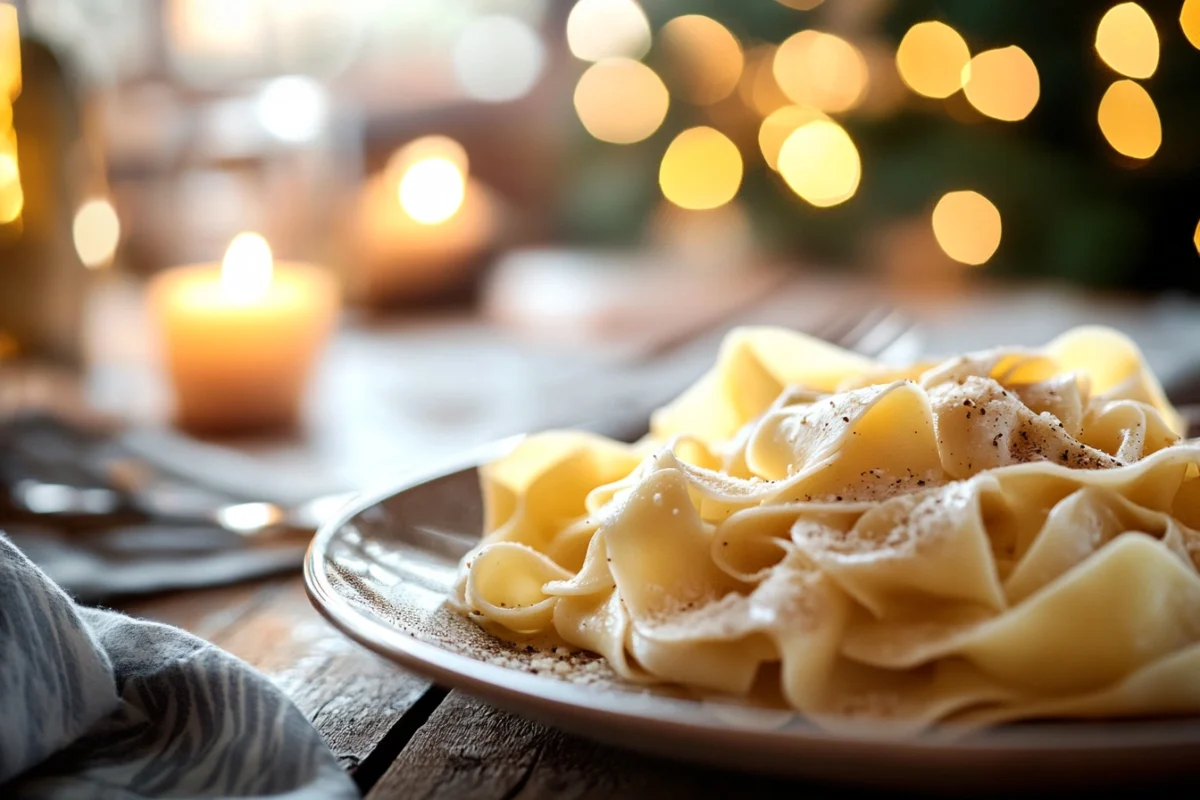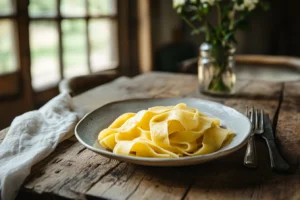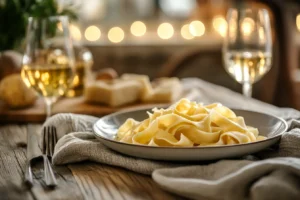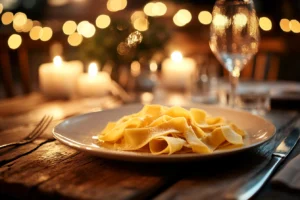Have you ever wondered how to say pappardelle pasta? This article will guide you through the pronunciation, origin, and uses of this delicious pasta. It will also delve into the cultural significance and cooking tips. Therefore, you will gain a complete understanding of pappardelle. Furthermore, you can confidently enjoy and discuss this culinary delight.
The Art of Pronouncing Pappardelle Pasta
Learning how to pronounce pappardelle pasta can seem tricky. However, with a little practice, you’ll master it. Therefore, we’ll break it down step-by-step. Firstly, let’s address the common pronunciation errors. Then, we will delve into the correct way to say it. Additionally, we will explore the phonetic nuances that often cause confusion. Consequently, you’ll be able to pronounce it like a native Italian speaker.
Understanding the Phonetics of Pappardelle
Pappardelle originates from Italian. So, the pronunciation is rooted in Italian phonetics. Basically, the word is broken into four syllables: “pap-par-del-le.” Therefore, pay attention to each part. Moreover, consider the emphasis. The stress falls on the second syllable, “par.” Consequently, this is crucial for correct pronunciation. Furthermore, the “lle” is a soft “leh” sound. It is not a hard “lee” sound. Additionally, this subtle difference is vital. Indeed, it sets the authentic Italian pronunciation apart. Furthermore, understanding these nuances is important. Therefore, you can correctly pronounce pappardelle. Additionally, each syllable plays a key role.
The Correct Way to Say Pappardelle
How do you pronounce pappardelle pasta correctly? Indeed, the answer is: “pah-par-del-leh.” The “a” in “pap” is like the “a” in “father.” Thus, practice this sound. Furthermore, the “r” is rolled slightly, as in Italian. Additionally, the “e” in “del-le” is short. Lastly, the “lle” is a soft sound, not “lee.” Hence, saying it slowly at first is helpful. Therefore, repetition is key to mastery. Moreover, pay special attention to the rolled “r”. This is a key element in Italian phonetics. Also, use online resources. This will help you hear the pronunciation from native speakers. Consequently, you will improve your accuracy and confidence. In addition, practice in front of a mirror to ensure your mouth forms the correct sounds. Thus, this will enhance your pronunciation.
The Origins and Characteristics of Pappardelle Pasta
After mastering how do you pronounce pappardelle pasta, you may wonder about its history. So, let’s discover the origin. Furthermore, we’ll look at its unique traits. Therefore, you will understand why it is so popular. Moreover, this knowledge enriches your appreciation. Consequently, you can savor the pasta on many levels. Furthermore, the characteristics affect its taste and texture. Thus, you can appreciate its culinary properties.
Tracing the Roots of Pappardelle
The origin of pappardelle pasta lies in the Tuscany region of Italy. Consequently, this pasta has a rich history. Moreover, it’s a regional specialty. Initially, it was a staple in the Tuscan countryside. Also, it was often made by hand. Additionally, the pasta is broad and flat. Therefore, it’s perfect for hearty sauces. Ultimately, its history reflects its rustic charm. Furthermore, its simple ingredients speak to its origins. Therefore, it’s an authentic Italian classic. Indeed, its timeless appeal stems from its roots. Additionally, it is a product of its environment and the traditional cooking methods. Consequently, it has a unique identity.
Identifying the Distinct Features of Pappardelle
Pappardelle is known for its wide, ribbon-like shape. Specifically, it is much wider than fettuccine. Indeed, this characteristic is important. Furthermore, it creates a great surface. Accordingly, this allows sauce to cling better. Also, its texture is slightly rough. Thus, it holds flavors beautifully. Additionally, pappardelle is generally made from egg-based dough. Consequently, it has a richer flavor. Moreover, you can find it fresh or dried. However, the fresh variety is preferred for its soft texture. Furthermore, the width of the pasta allows for a more substantial bite. Consequently, it is more satisfying. Also, the rough texture provides a more complex culinary experience.
Cooking and Serving Suggestions for Pappardelle
Now that you know how do you pronounce pappardelle pasta and its history. Let’s look at cooking methods. Also, explore serving ideas. Therefore, you can enjoy this pasta at home. Moreover, these tips will guide you to a great dish. Consequently, you can prepare pappardelle like a pro. Additionally, understanding the proper techniques enhances the cooking experience. Thus, you’ll be able to create delicious meals.
Basic Cooking Instructions for Pappardelle
Cooking pappardelle pasta is easy. First, bring a large pot of salted water to a boil. Afterwards, add the pasta. Next, cook it until it is “al dente.” This means it’s cooked but still firm. Moreover, cooking time will depend on whether the pasta is fresh or dried. For fresh pasta, it usually takes just a few minutes. Conversely, dried pasta may take 8-10 minutes. Subsequently, drain the pasta well. Finally, toss it with your chosen sauce. Therefore, you will have a perfect dish. Additionally, ensure that the water is properly salted. This will help flavor the pasta. Furthermore, avoid overcooking. Consequently, it will retain a pleasant texture. Also, make sure to stir the pasta occasionally. Thus, it won’t stick together during cooking.
The Best Sauces to Pair with Pappardelle
The wide shape of pappardelle pasta pairs perfectly with rich, hearty sauces. In particular, meat ragu or mushroom sauces are a great match. For example, a classic Bolognese sauce is a popular choice. Additionally, creamy sauces with vegetables or cheese also work well. However, lighter tomato-based sauces can also be suitable. In fact, the key is to choose a sauce that coats the wide noodles. Consequently, every bite is flavorful. Thus, experiment with different combinations. Moreover, consider the seasonality of your vegetables. This will create the best pairings. Also, taste and adjust the seasoning. Consequently, your dish will be even better. Additionally, a rich sauce ensures that the pappardelle is well coated. Thus, it will absorb the flavors.
Ideas for Elevating your Pappardelle Dishes
To enhance your pappardelle dish, try some simple additions. Consider adding a sprinkle of fresh herbs. For example, parsley or basil. Furthermore, add grated Parmesan cheese before serving. Also, a drizzle of olive oil enhances the taste. Therefore, you can create a special dish with minimal effort. In addition, consider adding roasted vegetables. For example, bell peppers or zucchini. Finally, for a truly indulgent touch, add some truffle oil. Moreover, consider adding a pinch of red pepper flakes for heat. This adds depth to the dish. Also, always use good quality ingredients. Consequently, you will achieve the best results. Furthermore, consider finishing with a squeeze of lemon. This will add brightness to the dish.
Common Mispronunciations of Pappardelle and How to Avoid Them
Even though the pronunciation of pappardelle might sound clear after the tips, it is commonly mispronounced. Hence, let’s explore common errors and how to fix them. Therefore, you can feel confident when you say pappardelle. Furthermore, this knowledge ensures that you communicate effectively. Also, understanding common errors will also improve your pronunciation. Additionally, knowing why these mistakes happen will help you avoid them.
Errors in Saying Pappardelle and How to Correct Them
Many people struggle with the double “p” and the “lle.” For instance, some might pronounce it “pap-ar-del-ee.” Therefore, focus on the correct sounds. Also, some might pronounce the “a” as in “cat.” However, remember it is like the “a” in “father.” Therefore, practice is essential. Moreover, avoid rushing through the word. Instead, pronounce each syllable carefully. Consequently, your pronunciation will improve. Additionally, pay attention to the rhythm of the word. The syllables should flow smoothly. Furthermore, consider using mnemonic devices. This will help you remember the correct pronunciation. Also, break down each part of the word. Therefore, this will help in learning the correct sounds.
Practical Tips for Perfect Pronunciation
To achieve perfect pronunciation, practice often. Try saying pappardelle slowly at first. Then, gradually increase your speed. Also, listen to audio examples of Italian speakers. Furthermore, try using online pronunciation guides. Additionally, record yourself saying the word. Therefore, identify any errors. Consequently, correct them immediately. Ultimately, the more you practice, the better you’ll become. Thus, you’ll eventually pronounce it perfectly. Moreover, be patient with yourself. It takes time and effort to master a new word. Furthermore, do not be afraid to ask for feedback. This will help you refine your pronunciation further. Also, practice in conversation with others. This way, you will gain confidence in saying it.
Exploring the Cultural Impact of Pappardelle Pasta
After exploring how do you pronounce pappardelle pasta, we’ll discover its place in culture. It is, after all, a food that is more than just a meal. It represents a rich tradition. Let’s look at some of its impact. Therefore, we can understand its importance. Moreover, recognizing its cultural significance enhances appreciation. Consequently, this adds another layer of enjoyment. Also, cultural context enhances our experience of food.
Pappardelle in Italian Cuisine and Tradition
Pappardelle plays an important role in Italian cuisine. Indeed, it is often served in traditional family meals. Also, it is a centerpiece at celebrations. Furthermore, its hearty nature makes it perfect for gatherings. Thus, this pasta represents the warmth of Italian hospitality. Accordingly, it symbolizes sharing and connection. Therefore, understanding the cultural aspect adds to its appeal. Moreover, pappardelle reflects the essence of Italian cooking. Consequently, it is not just a pasta; it’s a tradition. Also, it highlights the importance of food in family and community. Furthermore, it reflects the values and traditions passed down from generations.
Pappardelle in Modern Culinary Interpretations
In the contemporary culinary scene, pappardelle has evolved. For example, chefs use it in various innovative ways. Furthermore, they create new and exciting dishes. In addition, the traditional pasta is combined with modern flavors. Moreover, the wide shape makes it ideal for artistic plating. Therefore, the use of pappardelle reflects creativity. Consequently, it demonstrates the versatility of this pasta. Furthermore, chefs are incorporating global ingredients. This is used to create unique pappardelle dishes. Consequently, this shows the adaptability of the pasta. Also, it ensures its continued relevance in the world of gastronomy. In addition, it allows for new flavor profiles.
Frequently Asked Questions (FAQs):
How do you correctly pronounce pappardelle pasta?
The correct pronunciation is “pah-par-del-leh.” The stress is on the second syllable, “par.” Also, the “lle” is a soft “leh” sound. Remember to roll the “r” slightly. Pay close attention to the “a” sound in the first syllable.
What is pappardelle pasta?
Pappardelle is a wide, flat ribbon-like pasta. Originating from Tuscany, Italy. It is wider than fettuccine. Thus, making it perfect for hearty sauces. Also, it’s traditionally made with egg-based dough. Consequently, it has a rich flavor and texture.
What sauces pair best with pappardelle pasta?
Pappardelle pairs well with rich and hearty sauces. Consider options like meat ragu, mushroom sauces, or creamy sauces with vegetables and cheese. Additionally, try a simple tomato-based sauce with a touch of cream. Therefore, the wide shape of pappardelle works with many options.
How do you cook pappardelle pasta?
Boil salted water, add the pasta, and cook until “al dente.” Fresh pasta takes just a few minutes. Dried pasta may take 8-10 minutes. Drain well and toss with your chosen sauce. Also, do not overcook the pasta. Consequently, it will be mushy. Stir occasionally to prevent sticking.
Conclusion: Enjoying Pappardelle with Confidence
Understanding how do you pronounce pappardelle pasta is a small but valuable skill. After all, it allows you to enjoy this classic dish fully. Moreover, by knowing its history and how to prepare it, you are more appreciative. Therefore, you can share the art of pappardelle with confidence. So, go ahead and try it! Also, share your newfound knowledge with friends and family. Consequently, you can spread the joy of pappardelle. Furthermore, remember that cooking is a joyful experience. Hence, enjoy the process of learning and preparing new dishes. Additionally, sharing knowledge about food enhances the culinary experience.
- Discover how different pasta dishes are prepared in our Ultimate Guide to Turron.
- Pair your pasta meal with something sweet, like ideas from Naturally Delicious Fruit Cups.
- Interested in exploring another versatile kitchen ingredient? Check out the Greek Yogurt Guide for creative uses.




